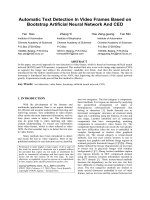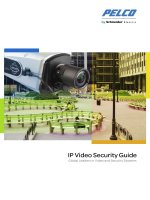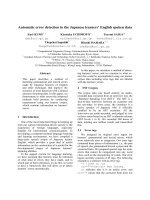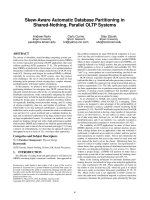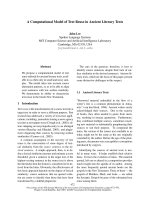Automatic text detection in video frames.
Bạn đang xem bản rút gọn của tài liệu. Xem và tải ngay bản đầy đủ của tài liệu tại đây (381.36 KB, 6 trang )
Automatic Text Detection In Video Frames Based on
Bootstrap Artificial Neural Network And CED
Yan Hao
Zhang Yi
Hou Zeng-guang
Tan Min
Institute of Automation Institute of Biophysics Institute of Automation
Chinese Academy of Sciences Chinese Academy of Sciences Chinese Academy of Sciences
P.O.Box 2728-9Dep P.O.Box P.O.Box 2728-9Dep
100080, Beijing, P.R.China 100101, Beijing, P.R.China 100080, Beijing, P.R.China
ABSTRACT
In this paper, one novel approach for text detection in video frames, which is based on bootstrap artificial neural
network (BANN) and CED operator, is proposed. This method first uses a new color image edge operator (CED)
to segment the image and achieve the elementary candidate text block. And then the neural network is
introduced into the further classification of the text blocks and the non-text blocks in video frames. The idea of
bootstrap is introduced into the training of the ANN, thus improving the effectiveness of the neural network
greatly. Experiments results proved that this method is effective.
K
ey Words:
text detection, video frame, bootstrap, artificial neural network, CED,
1. INTRODUCTION
With the development of the Internet and
multimedia applications, there is an urgent demand
for efficient and accurate content-based browsing and
retrieving systems. Text embedded in video frames
often carries the most important information, such as
time, place, name or topics, etc. This information
may do great help to video indexing and video
content understanding. To extract text information
from video frames, which is often referred as video
OCR, the first essential step is to detect the text area
in video frames.
Many methods have been introduced to detect
and locate the text in video sequence. Most of the
published methods for text detection can be classified
into two categories. The first category is component-
based methods. Text region are detected by analyzing
the geometrical arrangement of edges or
homogeneous color/grayscale components that
belong to characters [1]. Smith detected text as
horizontal rectangular structures of clustered sharp
edges [2]. Combining using the features of color and
size range, Lienhart identified text as connected
components that have corresponding matching
components in consecutive video frames [3]. The
component-based methods can locate the text quickly
but have difficulties when the text is embedded in
complex background or touches other graphical
objects [4]. The second category is texture-based
methods. Jain has used various textures in text to
separate text, graphics and halftone image regions in
scanned grayscale document images [1][5][6]. Zhong
further utilized the texture characteristics of text lines
to extract text in grayscale images with complex
backgrounds [1][7]. Zhong located candidate caption
text regions directly in DCT compressed domain
using the intensity variation information encoded in
the DCT domain [1]. Those texture-based methods
decrease the dependency on the text size, but they
have difficulty in finding accurate boundaries of text
areas. The two categories methods are limited to
many special characters embedded in text of video
frames, such as text size and the contrast between text
Permission to make digital or hard copies of all or part of
this work for personal or classroom use is granted without
fee provided that copies are not made or distributed for
profit or commercial advantage and that copies bear this
notice and the full citation on the first page. To copy
otherwise, or republish, to post on servers or to redistribute
to lists, requires prior specific permission and/or a fee.
Journal of WSCG, Vol.11, No.1., ISSN 1213-6972
WSCG’2003, February 3-7, 2003, Plzen, Czech Republic.
Copyright UNION Agency – Science Press
and background in video images. To detect the text
efficiently, those methods usually defined a lot of
rules that are largely dependent of the content of
video. Because the video background is complex and
moving/changing, traditional ways that tried to
describe the contrast between text and video
backgrounds have difficulty to detect text efficiently.
So it is significant to synthesize both the traditional
method using many locating rules and that based on
statistical models for detecting and locating text in
video frames.
In this paper, one new method based on
bootstrap neural network and CED operator is
proposed for text detection in video frames.
Compared with the traditional edge operator, the
CED (color edge detector) operates on the overall
effect of three channels of Y.I.Q color space.
Combining with morphological methods, the CED
can locate not only gray images but also color images
effectively. Artificial Neural Network (ANN) can
embed the statistical features of one pattern into the
structure and parameter of the ANN network. ANN
has the special merit for the complex video objects.
What is more important is that in this paper the idea
of bootstrap, which is proposed by Sung to detect the
face [8], is introduced into the training of ANN
network, thus improving the effectiveness of the
ANN greatly.
Figure 1. Flow chart of the proposed text
detection algorithm
Post-processing is important for segmenting the
text and the background in those images that have
been processed by CED. Because the text lines in the
video are usually horizontal, we must strengthen the
image’s horizontal edges. So the edge operator that
has longitudinal character is used here to extract the
edge of the image again after CED extracted it firstly.
In this paper, the longitudinal
operator is used
to extract edge after CED performed such operation.
In this way, the binary image is achieved and the
candidate text blocks can be located elementarily by
morphological methods. The algorithm is described
as follows:
sobel
Figure 1 shows the flow chart of the proposed
text location algorithm. Firstly, the CED is proposed
to detect the edges of the original image and
morphological methods are used to get the candidate
blocks. Secondly, some rules are introduced to
classify the blocks into text blocks and non-text
blocks. Thirdly, the Gabor texture features are input
as the train samples into the ANN to train the
network. The bootstrap is introduced into this process.
Those non-text blocks that are classified as text-
blocks falsely are put in the non-text block training
set of ANN as the new non-text blocks training
samples. Finally, the ANN is used to classify the text
blocks and non-text blocks after it is fully trained and
then the detection result is achieved.
2. TEXT REGION DETECTION BASED
ON CED
2.1 CED operator
High-level accuracy and ability for removing
noises are the important requirements for the edge
detection of color images, just as that of gray images.
Here the traditional Roberts Operator is transformed
into CED
that
makes use of the Y.I.Q color system.
Considering that the Y, I and Q have different
influences on video images, the different weight
numbers are introduced to balance those influences.
The CED operator is described as follows:
CED=
2
2
2
1
δδ
+
(1)
Where
1
δ
and
2
δ
are defined as:
);1,1,,(
1
++= jijiDis
δ
);1,,,1(
2
++= jijiDis
δ
(2)
Where
is defined as the Eulerian
distance between two pixels of the image in Y.I.Q
color system, its definition is:
),,,(
2211
jijiDis
[ ]
[]
[]
2
1
2
22113
2
22112
2
221112211
},,( ),,(
),,( ),,(
),,( ),,( {),,,(
qjiIqjiI
ijiIijiI
yjiIyjiIjijiDis
−+
−+
−=
λ
λ
λ
(3)
2.2 Elementary Text Detection Based on
CED
3. TEXT BLOCK CLASSIFICATION
BASED ON BOOTSTRAP ANN
(BANN)
(1) The original image in one of the video
frames is processed by CED to get the grayscale
edge image
。
1
I
2
I
(2) is processed by longitudinal
sobel
operator to get the binary edge image
。
2
I
3
I
After the image is processed in the way
described above, the text blocks are located
elementarily. The following task is to locate the text
blocks more accurately and remove non-text blocks
that are often classified as text blocks by the CED.
Due to the complexity of the images in video frames,
the BANN is used to further classify the text blocks
and non-text blocks.
(3) is processed by morphological methods
to get the image
I
。 Considering the horizontal
features of texts in video images, we use the open
operator to dilate
in horizontal direction and then
use the close operator to erode it in morphological
direction.
3
I
4
3
I
3.1 Artificial Neural Network (ANN)
In this paper, the Back Propagation (BP) ANN is
adopted for classification. BP neural network is the
most widely used neural network model. Its merit is
that is has strong ability of nonlinear projection and
flexible network structure. All of its network
structure, the number of layers, the number of nerve
units and study coefficients can be adjusted according
to the specific cases. And to realize such models is
easy and quick. The structure of the BP artificial
neural network is described in figure 2:
After the processing described above is finished,
some important rules are designed to locate some
obvious text blocks and remove some obvious non-
text blocks. Both the features of horizontal and
longitudinal projection of image
I
and the density
features of it are considered to locate the text
elementarily. The detailed rules are as follows:
4
(1) When both the horizontal projection
and the
longitudinal projection of one block do not
meet the inequality (4), this block is classified into
non-text block set. To avoid the influence of text size
on the algorithm, the pyramid method is used to
extract the text in video images with different
resolutions. That is, the images in different
resolutions are classified respectively. And then the
results got in different resolution are combined to get
the final classification. Here if all of the block images
in different resolution do not meet the inequality (4),
those blocks are classified as non-text blocks.
h
P
v
P nm
×
Figure 2. Structure of BP Neural Network
There are two output nodes of BP network in
this paper, corresponding to the text block and non-
text block respectively.
1
µ
>
h
P
and
2
µ
>
v
P
(4)
where
1
µ
and
2
µ
are the low limit of
horizontal and longitudinal projection respectively.
3.2 Feature Selection of Input Nodes of Back
Propagation Neural Network
(2) When the density of
m
block are less than
the threshold
n
×
3
µ
,the block is classified as non-text
block 。 Where
3
µ
is defined as the low limit of
density determined.
Because the text in video has the special texture,
we adopt the texture characters of candidate blocks as
the features to be recognized. Multichannel Gabor
filter is a well-established method for texture analysis
and has been demonstrated to have good performance
in texture discrimination and segmentation [9]. In
theory, any kind of texture analysis methods can be
employed here. But experiments show that the Gabor
filter has better performance [10] [11] [12], and
therefore is used in this paper.
(3) When the
nm
×
block meet both
4
µ
>
density
and (4),the block is classified as text
block. Where
4
µ
is defined as the low limit of
density.
Then the elementary detection process is
finished. And the rest of the candidate blocks except
for those determined by the rules given above are to
be processed by the neural network in the following
section.
3.2.1 The Concept of Gabor Filter
In this paper, we use pairs of isotropic Gabor
filters with quadrature phase relationship [10]. The
models in spatial domain is as follows:
)]sincos(2cos[),,(),,,,(
θθπσσθ
yxfyxgfyxh
e
+×=
(5)
Figure 3. Frequency Response of Gabor Filter
3.2.3 Filter Design
)]sincos(2sin[),,(),,,,(
θθπσσθ
yxfyxgfyxh
o
+×=
Each pair of the Gabor filters
are tuned to a specific band of
spatial frequency and orientation, which respond to
and
),( ),,( yxhyxh
oe
f
θ
. How to select these parameters is an
important problem. Tan presented that there is no
need to uniformly cover the entire frequency plane so
far as texture recognition is concerned [13]. He also
pointed that since the Gabor filters are of central
symmetry in the frequency domain, only half of the
frequency plane is needed. So four values of
orientation are selected:
. Zhu
pointed that in order to achieve good results, for an
image of size
N
0000
135,90,45,0=
θ
N×
, central frequencies are chosen
within
4/Nf <
[10]. In our experiments, the input
image is tuned to the normal size
128
. For each
orientation
128×
θ
, we select 2, 4, 8, 16, 32 as frequencies,
getting a total of 20 Gabor channels (
2054 =×
, 4
orientations and 5 central frequencies). The spatial
constant
γ
is chosen as:
01.0=
γ
.
where
),,,,(
σθ
fyxh
e
and
),,,,(
σθ
fyxh
o
)
responds
to so-called even- and odd-symmetric Gabor filters
respectively, and
,,(
σ
yxg
is an isotropic Gaussian
function that is described as follows:
+
−×=
2
22
2
2
exp
2
1
),,(
σπσ
σ
yx
yxg
(6)
σθ
,,f
in (5) are three important parameters. They
are spatial frequency, spatial orientation, and space
constant of the Gabor envelope respectively. It is
important to understand how to solve the problems in
frequency domain for Gabor filter. So it is necessary
to know the frequency responses of the Gabor filters
that is described as follows:
2
)],(],[[
),(
21
vuHvuH
vuH
e
+
=
j
vuHvuH
vuH
o
2
)],(],[[
),(
21
−
=
(7)
3.2.4 Features Extracted by Gabor Filters
where
1−=j
,
and are
:
),(
1
vuH ),(
2
vuH
[
{
)sin()cos(2 exp),(
2222
1
θθσπ
fvfuvuH −+−−=
]
}
(8)
[]
{}
)sin()cos(2 exp),(
2222
2
θθσπ
fvfuvuH −++−=
In our experiments, the mean values (
q
) and the
Standard deviation (
γ
) of the channel output images
are chosen to represent the features. The definition
of them is
∑∑
==
×
=
N
x
N
y
yxq
NN
q
11
),(
1
3.2.2 Frequency Response
∑∑
==
×
−
=
N
x
N
y
NN
qyxq
11
2
] ),( [
γ
(11)
As described in Figure 3, the relationship
between the input image p(x,y) and output image
q(x,y) is :
Thus, a total of
20 402 =×
features are extracted
from the input image. Figure 4 shows the flow chart
of coarse feature extraction using Gabor Filters.
),(),(),(
22
yxqyxqyxq
oe
+=
),(),(),( yxpyxhyxq
ee
⊗=
),(),(),( yxpyxhyxq
oo
⊗=
(9)
where
⊗
is defined as convolution. In practical
application, we usually use the Fourier Transform to
calculate the convolution. That is:
[]
),(),(),(
1
vuHvuPFFTyxq
ee
×=
−
[
),(),(),(
1
vuHvuPFFTyxq
oo
×=
−
]
]
(10)
where , which is the Fourier
Transform of
.
[
),(),( yxpFFTvuP =
),( yxp
Figure 4. The feature extraction of Gabor Filter
input p(x,y) output q(x,y)
3.3 Bootstrap of BP Neural Network and
Text Block Recognition
GABOR Filter
),(),,( yxhyxh
oe
Figure 5. Experimental Results 1
Just as those described in Figure 1, the blocks
got by CED are first classified into text blocks and
non-text blocks that are included into text block
sample set and not-text block sample set for training
the BP network respectively. The non-text block
sample set is originally a very small set. Then the
Gabor features of these blocks are input to train the
BP network. During the training process, the
bootstrap is introduced into our method. Bootstrap
means that when the output of the BP network is text
block that is in fact non-text block and classified
falsely by BP network, this block is then included in
the training sample set for non-text block. The
process is iterated steadily until the non-text block
samples are enough for training the network. Then a
complete detection model is built up for text
detection in video frames.
(a) (b) (c)
(d) (e) (f)
Figure 6. Experimental Results 2
4.IMPLEMENTATION AND
EXPERIMENTAL EVALUATION
4.1 Experimental results
The experiments are performed following the
algorithm presented in this paper. The experimental
data are from the various videos of some movies. The
total length of these videos is about 70 minutes. The
testing data contain 205 video frames. Figur 5 and
Figure 6 show the total process of text detection. In
the images shown in each of them, (a) shows the
original image
,
(b) shows the edge image got
by CED
,
(c) shows the binary image
I
got after
is processed by open morphological operator, (d)
shows the binary image
I
got after
I
is processed
by close morphological operator, (e) shows the image
got by BANN, (f) shows the final detection results in
the original video image. Figure 7 (a), (b), (c) and (d),
(e), (f) are two other experiments respectively, in
which the first one is the original image, the second
one is the image processed by BANN, the last one is
the detection result. From those images, we can see
that although the background is complex, the
detection of the text is accurate and effective.
1
I
2
I
3
2
I
4 3
(a) (b) (c)
(d) (e) (f)
Figure 7. Experimental Results 2
4.2 Experimental Evaluation
The statistical experimental results are listed in
Table 1.
Total_Frames
205
Total_Text_Blocks
964
Total_Missed_Text_Blocks
59
Total_False_Alarms
63
Detection_Rate
87.3%
False_Alarm_Rate
6.54%
Table 1. Statistical Detection Results
(a) (b) (c)
Where
False_Alarm_Rate
and
Detection_Rate
are defined respectively as follows:
False_Alarm_Rate
=
BlocksTextTotal
AlarmsFalseTotal
__
__
)
Detection_Rate =
BlocksTextTotal
BlocksTextDetectedTotal
__
__
−
(d) (e) (f)
